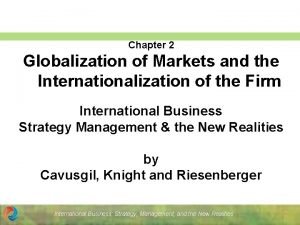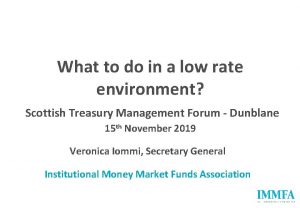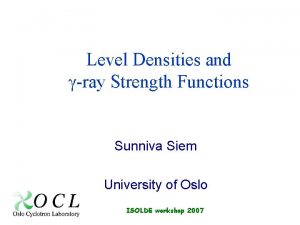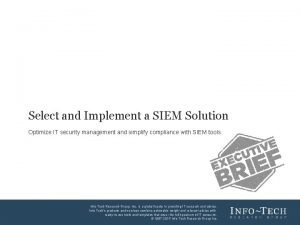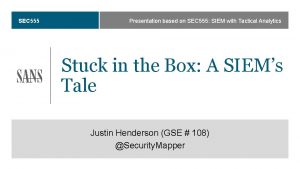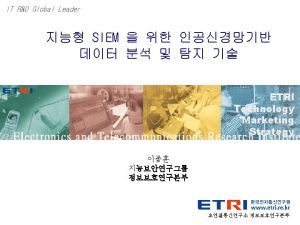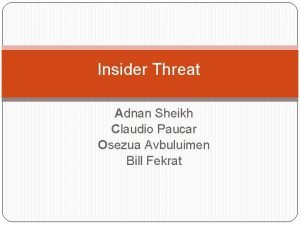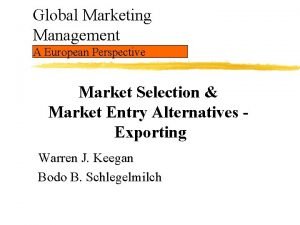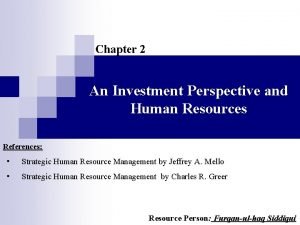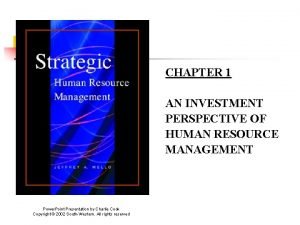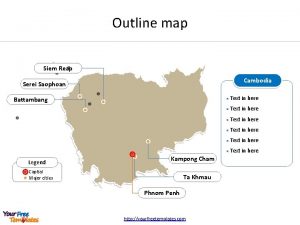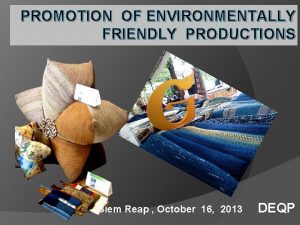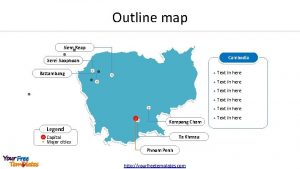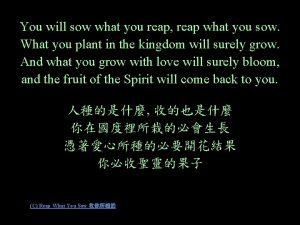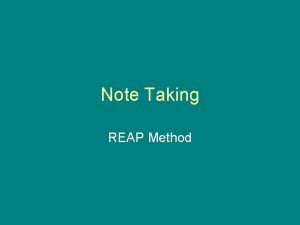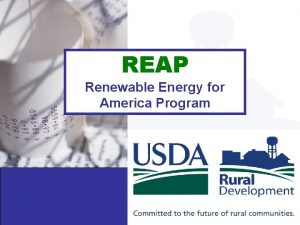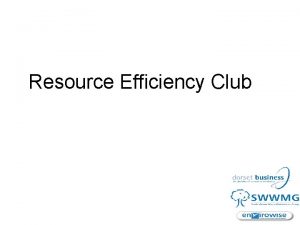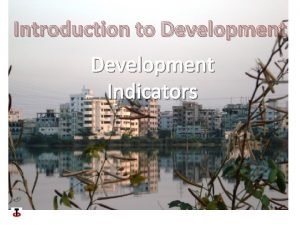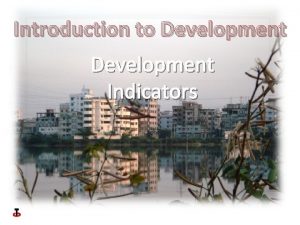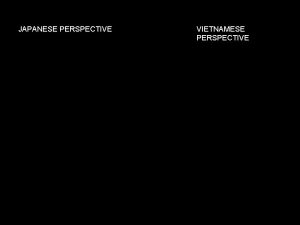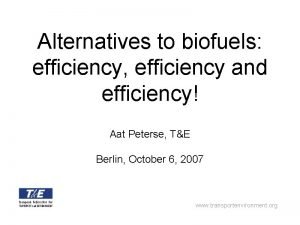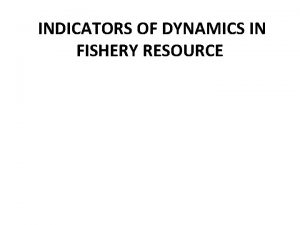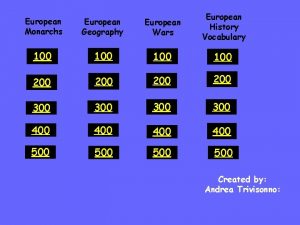Resource Efficiency Indicators A European Perspective Siem Reap
























- Slides: 24

Resource Efficiency Indicators: A European Perspective Siem Reap, Cambodia October 16, 2013 Meghan O’Brien Wuppertal Institute

What is resource efficiency? § Efficiency compares the inputs to a system with its outputs; it essentially means achieving “more with less”. § Occurs across all levels of society; Depends on where to draw the system boundary – micro level: often associated with company improvements to produce their products more efficiently – macro level: it is about optimizing the flow of natural resources across the economic system of production and consumption (doing “better with less”).

Why resource efficiency in the EU? “Increasing resource efficiency is key to securing growth and jobs for Europe. It brings major economic opportunities, improves productivity, drives down costs and boosts competitiveness. ” -from the website of the European Commission

Where is resource efficiency in policies? § Embedded in the EU Growth Strategy (Europe 2020) for building smart, sustainable and inclusive growth for Europe - Flagship initiative “A resource-efficient Europe” (January 2011) - Toward a cross-cutting, integrated approach: Not only launched by the environmental General Directorate, but also by the President of the European Commission

What are the policy goals related to RE? Roadmap for a resource-efficient Europe (September 2011) § A vision for 2050; milestones to be reached by 2020 § “By 2050 the EU's economy has grown in a way that respects resource constraints and planetary boundaries, thus contributing to global economic transformation. Our economy is competitive, inclusive and provides a high standard of living with much lower environmental impacts. § Vision combines environmental, social and economic dimensions of sustainability under the umbrella of macro-economic resource efficiency. § Targets should not only measure progress on improving EU resource efficiency, but also need to reflect the overarching capacity for sustainable supply of the global Earth system

What are resource efficiency indicators? Process § An assessment of resource efficiency targets and indicators (2011) § Stakeholder consultation (2012): 164 responses (compared to around 46 in 2005) § Suggestion expected this year Table: Number of responses Consultation on the Thematic Strategy (December 2004 -January 2005) Consultation on Resource Efficiency Indicators (July to October 2012) Industry and business 25 87 NGOs 5 30 Government authority 10 20 Academia 4 16 Individual 2 3

What are resource efficiency indicators The three-layered approach to resource efficiency indicators Source: online resource efficiency platform 7

Lead Indicator: Resource productivity § In general, one headline indicator has the strength of being highly visible, but issues better covered by a dashboard § Proposed GDP • Shortcomings of GDP as an indicator; does not reflect well -being • Rich countries perform better / DMC • Related just to consumption, not consumption and production activities • Indirect flows and unused extraction not included • Discussion on weight

What is DMC? § Derived from economy-wide material flow accounting. § Possible to derive a number of indicators from MFA. Consumption is domestic extraction + imports – exports. Inputs Outputs Resources domestically extracted Air emissions, waste disposal, etc. Imports from other economies Economy Stocks Exports to other economies

Economy-wide resource efficiency indicators § Whether indirect flows and unused extraction are taken into account determines how comprehensive the indicator set is. – Indirect flows (ecological rucksacks) are used along the production chain to produce a traded good, but do not cross national borders – Unused extraction is the extraction not used like overburden from mining, harvest losses and by-catch in fishing http: //commons. wikimedia. org/wiki/Fil e: Hidromek_excavator. jpg

Economy-wide input & consumption indicators Policy questions Type of indicator Name Derived by Input Direct Material Input (DMI) Domestic extraction used + imports How many environmental resources are used in domestic production and consumption? Input Raw Material Input (RMI) DMI + ecological footprints How much primary material is directly used in domestic production and consumption? Input Total Material Requirement (TMR) RMI + unused domestic extraction + resource requirements of imports How much primary material is required globally by domestic production and consumption? Consumption Domestic Material Consumption (DMC) DMI - exports How many environmental resources are used for domestic consumption? Consumption Raw Material Consumption (RMC) RMI – exports (incl. ecological rucksacks) How much primary material is directly used for domestic consumption? Consumption Total Material Consumption (TMC) TMR – exports – indirect flows associated with exports How much of the global primary material requirement is associated with domestic consumption?

DMI versus TMR Trends in per capita resource requirements of the EU-27, DMI and TMR Tonnes per capita Source: ETC/SCP 2011

Discussion on weight § 1 gram of sand is not the same as 1 gram of copper § Efforts underway to develop a composite “eco-efficiency” indicator, with the aim of combining decoupling of resource use and the environmental impacts of resource use into one indicator. – adds layers of unnecessary complexity – “hides” assumptions about impacts – weighting becomes an issue

Dashboard indicators § The Roadmap: indicators should “take into account the global aspects of EU consumption. ” § Broad consensus on appropriateness of a dashboard approach

Options for dashboard indicators – Bio Intelligence Services 2011 Resource use-oriented indicators Material use Energy use and climate Water use Land use Env. Impact-oriented indicators Short-term (1 year) Medium-term (2 -5 years) Domestic Material Consumption (DMC) Raw Material Consumption (RMC) Environmentally. Weighted Material Consumption (EMC) Life-Cycle Resource Indicator (by JRC) Gross inland energy consumption Actual primary energy consumption (incl. energy flows “embodied” in trade) Territorial GHG emissions (UNFCCC/Kyoto) Carbon Footprint (incl. GHG emissions “embodied” in trade) Water abstraction (only blue water) Water Footprint (blue and green water) Water Exploitation Index (only blue water; territorial) Global Water Consumption Index (blue and green; incl. “embodied” water) Domestic Land Demand Actual Land Demand (incl. land use “embodied” in trade) Human Appropriation of Net Primary Production (HANPP) e. HANPP, LEAC and other indicators on ecosystem quality

Options for dashboard indicators Territory or national perspective Materials Land Domestic extraction (used and unused), DMI, DMC Artificial land or built-up area (km²) Global supply chain or international perspective Available for all EU Member States TMR and TMC Available for the EU-27 (aggregated) and some MS Available with restrictions in time series Direct and Indirect land use / "embodied" land for consumption of biomass-based products focussing on cropland (ha) Available for the EU-27 (aggregated) Water exploitation index (WEI, %) Limited availability Water footprint or "Embodied" water In need of improvement; In need of development GHG Emissions GHG emissions (t) Available Direct and indirect GHG emissions Available

Thematic indicators Measuring policy effectiveness § § Transforming the economy Natural capital and ecosystem services Key sectors Governance and monitoring

Thematic indicators: monitoring policy effectiveness Transforming the economy Changing consumption patterns Supporting GPP -Percentage of the value, and number, of public procurement contracts that include GPP criteria Promoting green buying –Number and value of green products purchased by households –Alternatively: output or share of green products in total output Boosting efficient production Measuring managing and improving European companies’ RE -Proportion of companies using environmental footprint Phasing out most harmful chemicals -Number of known 'substances of very high concern’ included on the REACH Candidate list Turning waste into a resource Ensuring full implementation of waste legislation, in line with the waste hierarchy Supporting research and innovation Increasing investment in research and innovation on resource efficiency Phasing out inefficient subsidies To be developed Getting the prices right Increasing the share of environmental taxation –Total waste generation; –Overall recycling rate; –Landfill rate; –Proportion of secondary raw material used in the economy compared to primary RW (TBD) -Number and value of funding (€/year) of research and innovation projects promoting mainly RE and sustainable environmental management, allocated through financial support programmes –Environmental taxes as share of total taxes and social contributions –Total value of environmental taxes paid

Thematic indicators: monitoring policy effectiveness Natural capital and ecosystem services Ecosystem services Mapping and assessing the state and value of ecosystems and their services Maintaining and enhancing ecosystems and their services Biodiversity Halting the loss of biodiversity and ecosystem services and restoring them as far as possible Minerals and metals -Resource productivity of minerals and metals Water Ensuring good quality and quantities of water Safeguarding clear air Achieving air quality with no significant negative impact on health and the environment –Concentrations of Particulate Matter in ambient air –Percentage of urban population in areas with PM 10 concentrations exceeding daily limit values Land Soils Reducing the anthropogenic pressure on ecosystems from land take –Average annual land take Reducing soil erosion Maintaining soil organic matter levels Identifying and remediating contaminated sites Marine resources Ensuring fish and shellfish are within maximum sust. Yield Achieving good environmental status in all waters -The number and area of Marine Protected Areas

Thematic indicators: monitoring policy effectiveness Key sectors Addressing food Making food consumption healthier and more sustainable -Development in consumption of meat and dairy products Reducing food waste -Share of edible food waste in households, retailers and catering Improving buildings Promoting green buildings –The rate of nearly zero-energy new buildings (TBD) –Energy consumption per m 2 for space heating, per dwelling and for total housing stock alongside growth in m 2 of living space per capita (TBD) Ensuring efficient mobility Transforming transport –CO 2 emissions in the transport sector –Total energy consumption/km driven as a proxy for energy efficiency in transport –Average CO 2 emissions per km for new passenger cars –Pollutant emissions (NOx, VOC, PM) from the transport sector --Energy consumption by fuel type

Thematic indicators: monitoring policy effectiveness Governance and monitoring Financing resource efficient innovation and investments –Share of total budget spent on the environmental and resource efficiency measures –Capitalisation of ‘Core’ and ‘broad’ Sustainable and Responsible Investments (SRI) (TBD) Supporting resource efficiency internationally

What are the (potential) targets? Per capita resource use and climate targets (Including policy targets and indicative targets based on discussions in literature) Dashboard categories Year Targets Implications for Europeans Source Materials 2050 10 tonnes TMCabiotic/ cap (-68% in per capita resource use compared to 2008) Based on Bringezu 2011 Land 2050 (0. 18 ha cropland /cap*) (-43% in per capita cropland use compared to 2007) Based on Bringezu et al. 2012 -- Target under development 2020 (2. 9 TOE / cap) 2050 (1. 8 TOE /cap) 2020 (8. 7 t CO 2 eq/cap) 2050 (2 t CO 2 eq/cap) Water Energy and climate Water abstraction in relation to total renewable water lower than 10% by 2050 -20% per capita Primary Inland Energy consumption compared to baseline projection for 2020 -50% per capita Primary Inland Energy consumption compared to 2000 -20% GHG emissions per capita compared to 1990 -80% GHG emissions per capita compared to 1990 EEA 2010 EC 2010 a Bio Intelligence Service et al. 2011 EC 2010 a EC 2011 c

Summing up § Potentially useful information sources from EU experiences for indicator development § Discussion is still ongoing regarding especially weight and indirect flows § Policy framework and policy goals reflect indicator development Questions/Discussion points § Should national indicators account for global impacts? § How can a harmonised indicator set be used for national policy making? What additional SCP indicators on national level.

Many thanks! meghan. obrien@wupperinst. org
 As market globalization intensifies
As market globalization intensifies R15 reap
R15 reap You reap what you harvest
You reap what you harvest Don't judge each day by the harvest you reap
Don't judge each day by the harvest you reap Whoever sows sparingly
Whoever sows sparingly Allocative efficiency vs productive efficiency
Allocative efficiency vs productive efficiency Productively efficient vs allocatively efficient
Productively efficient vs allocatively efficient Productive inefficiency and allocative inefficiency
Productive inefficiency and allocative inefficiency Environmental and resource efficiency issues
Environmental and resource efficiency issues Sunniva siem
Sunniva siem Siem implementation steps
Siem implementation steps Open source siem
Open source siem Managed siem adelaide
Managed siem adelaide Sec555: siem with tactical analytics
Sec555: siem with tactical analytics Siem
Siem Threat
Threat Soc tier 1
Soc tier 1 Scoring model for international market selection
Scoring model for international market selection Resource leveling is the approach to even out the peaks of
Resource leveling is the approach to even out the peaks of Perbedaan antara resource loading dan resource levelling
Perbedaan antara resource loading dan resource levelling Investment perspective of human resource management
Investment perspective of human resource management An investment perspective of human resource management
An investment perspective of human resource management 2 point perspective windows
2 point perspective windows Silo perspective vs business process perspective
Silo perspective vs business process perspective Understanding the efficiency of ray traversal on gpus
Understanding the efficiency of ray traversal on gpus
